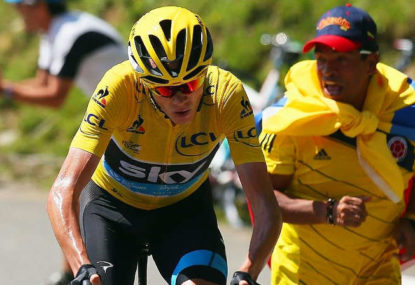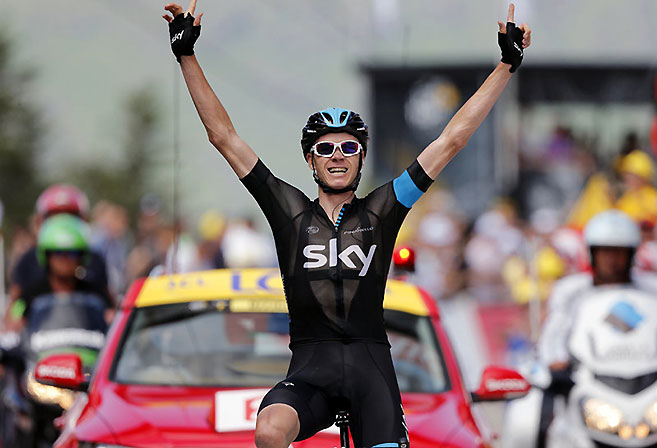'I've just won a stage of the Tour de France, mate!': Hindley grabs yellow jersey as Aussie blows Tour apart
Australia's Jai Hindley has said he is "lost for words" after a shock stage victory at the Tour de France earned him the leader's…

Days out from what promises to be one of the most exciting and closely fought Tours de France seen in years, here we are again, talking about drugs in cycling. Is anyone even remotely surprised?
Just hours after the Amaury Sport Organisation (ASO) – organisers of the Tour – reportedly told Team Sky that Chris Froome would not be permitted to compete at this year’s event, the Union Cycliste Internationale (UCI) cleared the Briton of any wrongdoing in a doping case that has dragged on for some ten months.
This, after almost a year of obfuscation and conflicting reports from cycling’s global body.
In fact, their only steadfast line throughout the whole fiasco had been that Froome’s was such a complex case that sorting it out before the Tour began was virtually impossible.
Yet within 24 hours of the ASO allegedly saying the reigning champ was out, suddenly we have a resolution?
To be fair, the UCI are claiming they had received notification from the World Anti-Doping Agency (WADA) that Froome was in the clear on June 28, but if that was the case and they’ve had five days to put together a definitive report on how Froome is in the clear, why the hell was their explanation so weak?
The UCI’s statement on the matter reads, in part: “In light of WADA’s unparalleled access to information and authorship of the salbutamol regime, the UCI has decided, based on WADA’s position, to close the proceedings against Mr Froome.”
Basically, after a year of billowing smoke, the announcement is: “Don’t worry, no fire here… Because just trust us, that’s why.”

(Image: Team Sky)
The UCI say they have “prepared and issued its formal reasoned decision”, but, at the time of writing, it’s yet to be made public. And that’s a serious issue, because Froome’s case is seriously complex, meaning immediate clarity was required on the final outcome.
For the uninitiated, on September 7, 2017, during the Vuelta a Espana – the tour of Spain, one of cycling’s three Grand Tours, and a race Froome won – Froome returned an abnormal finding during a doping control.
Specifically, his sample contained “a concentration of salbutamol in excess of 1000ng/ml”. Salbutamol is a commonly used drug for those who have asthma, which Froome has “suffered with” since he was a child.
Without getting too technical, WADA have the drug on their Prohibited List, but acknowledge that salbutamol is a broadly used medication for a common disease – so you’re allowed to have it in your system for therapeutic use, but only to a certain amount, and Froome had exceeded that amount.
In fact, he was found to have roughly double the permitted dose in his body – although Team Sky said he was only 19 per cent over the maximum level – which WADA’s Prohibited List says “will be considered as an Adverse Analytical Finding (AAF) unless the Athlete proves, through a controlled pharmacokinetic study, that the abnormal result was the consequence of the use of the therapeutic dose (by inhalation) up to the maximum dose indicated”.
Apologies for the jargon-heavy quote, but it’s important – specifically, the part about providing a controlled pharmacokinetic study (CPKS).
According to a 2011 study from the Journal of Bioequivalence and Bioavailability, “Pharmacokinetics provides a mathematical basis to assess the time course of drugs and their effects in the body.”
And this is where things get tricky.
While the UCI media release was light-on (read: almost completely absent) of an explanation as to how Froome had been cleared, WADA’s was a bit more in-depth.
Again, without getting too technical, WADA were satisfied that Froome’s physical state at the time of the AAF – he was sick and had been taking the drug at varying doses over the past three weeks in a state of intense physical strain – meant he could have been above the accepted limit without having ingested more than “the permitted maximum inhaled dose”.
However, WADA’s rule says an excess of salbutamol would be found to be an AAF unless proof otherwise could be provided through a CPKS.
So what was the result of Froome’s CPKS? Well, he didn’t actually provide one.
“WADA accepts that a CPKS would not have been practicable as it would not have been possible to adequately recreate the unique circumstances that preceded the 7 September doping control,” the WADA statement read.
WADA will not appeal UCI decision in Christopher Froome case: https://t.co/xWWVon6jSM
— WADA (@wada_ama) July 2, 2018
Now, Froome and his team submitted a 1500-page report in his defence – it’s not as though he simply said, “Guys, trust me, I didn’t do anything wrong.” But when the rules explicitly state that a CPKS is required to prove innocence, then the athlete is let off while the anti-doping agency essentially says ‘it’d be too hard to provide one of those’, things look fishy.
I want to be absolutely crystal clear about this: I’m not accusing Chris Froome of doping. He’s maintained his innocence throughout the saga and has now been vindicated by the sport’s governing body.
The issue here lies with that governing body and WADA. WADA has been around since 1999, so they and the UCI were the watchdogs under which we’ve seen Alberto Contador, Floyd Landis and Lance Armstrong all stripped of Tour de France titles.
Thanks to the events in which those three aforementioned athletes were part of, these bodies lack credibility on the matter of catching cheats, so it was of the utmost importance that a full reasoned decision, which outlined exactly how and why Froome has been exonerated, be made public along with the press releases.
What’s more, that would be in Froome’s best interests. As he said in a statement after the case was dropped, “I understand the history of this great sport – good and bad.” That means he must know an all-clear without exhaustive evidence explaining why isn’t worth much to the general public.
Instead, we got the same old ‘nothing to see here’ routine.
As leading anti-doping expert Robin Parisotto told Cyclingnews, “This is another high-profile case where the outcome has not been handled or managed very well because 24 hours ago the ASO gave Froome the finger and now the UCI has said ‘bugger everyone, he’s racing.'”
Look, maybe the reasoned decision will be made public before this piece goes live – Froome actually told Sky Sports News, “All of that will be fully communicated in the media in the next few days about how we got to this point.”
But in the 24-hour news cycle, the headline ‘Froome innocent’ is going to get a lot more play than ‘Here’s why’ a few days later.
Regardless, the whole fiasco has been so poorly handled that you’d almost think we were dealing with a sport that hasn’t been exposed to this kind of scrutiny over its doping controls virtually non-stop for the past two decades.